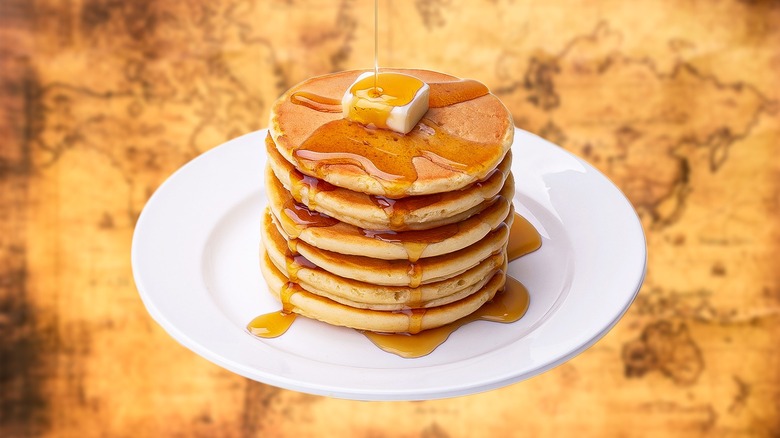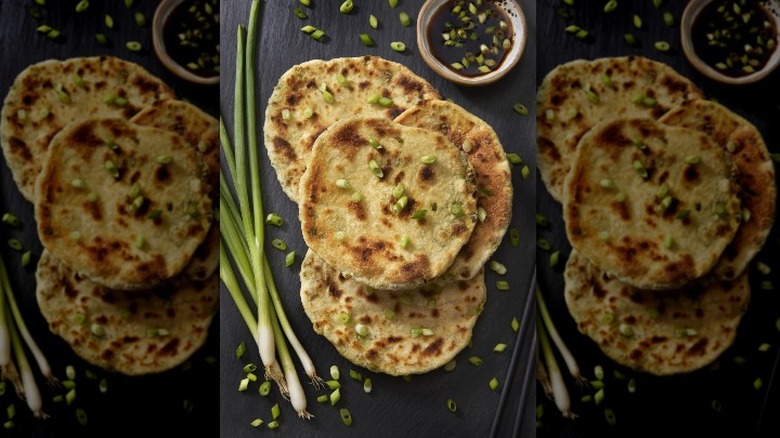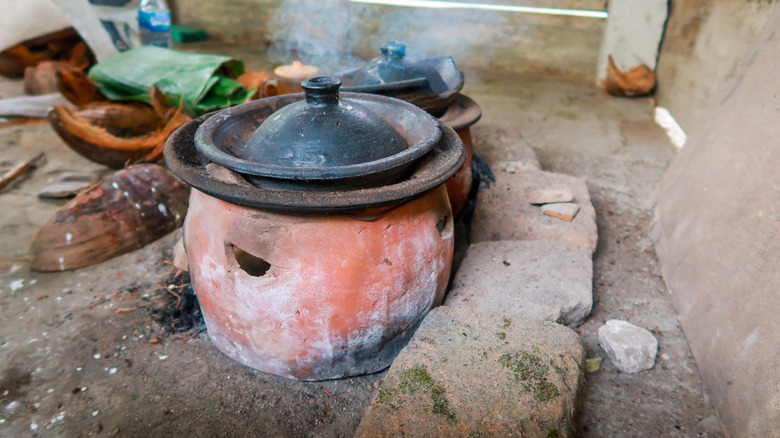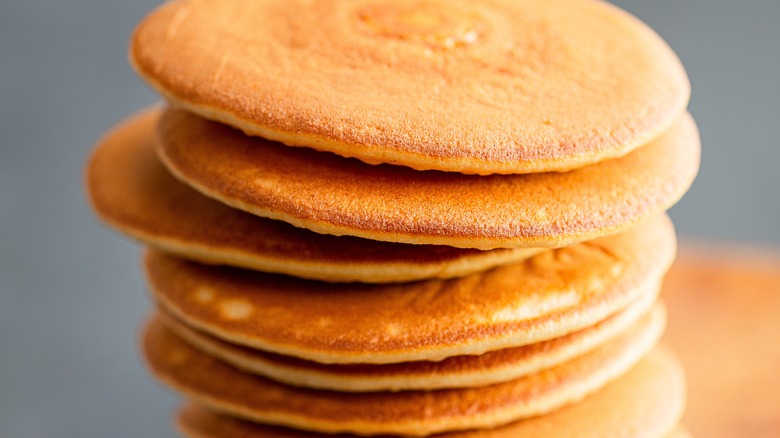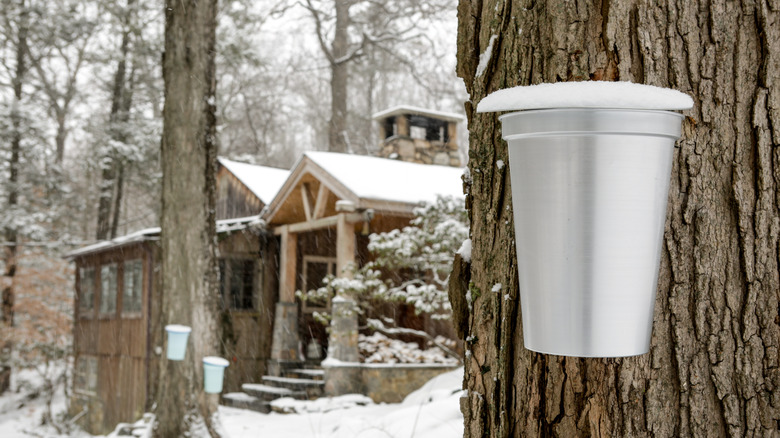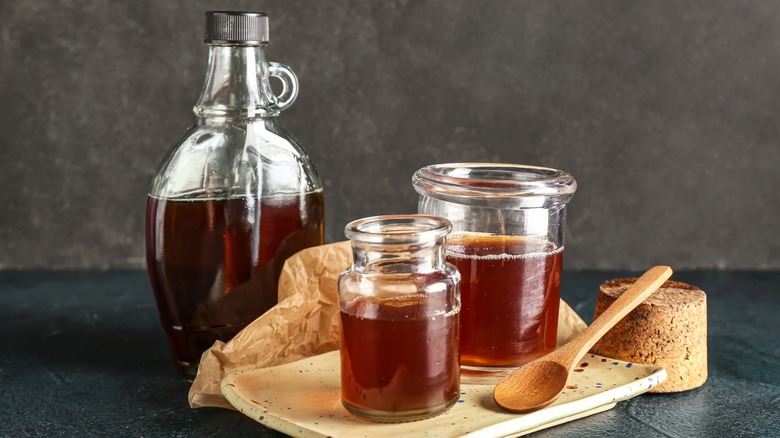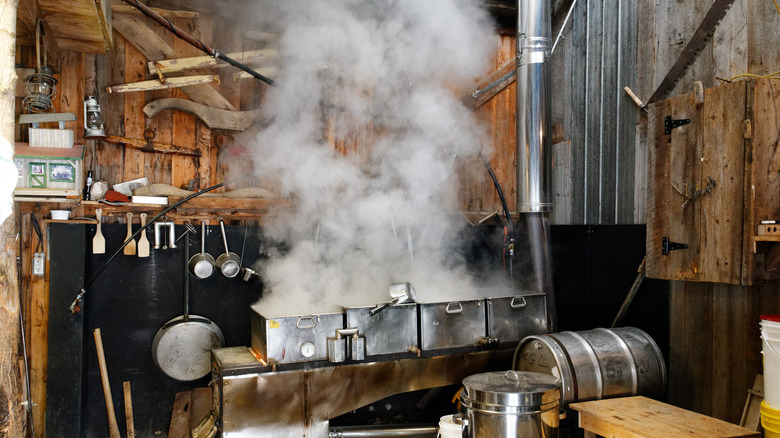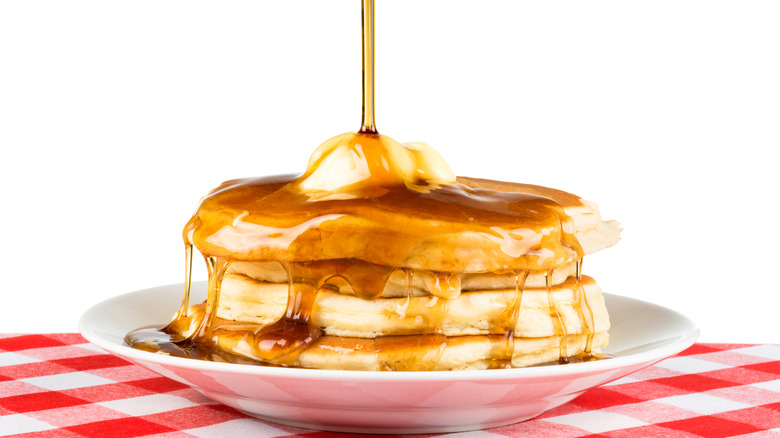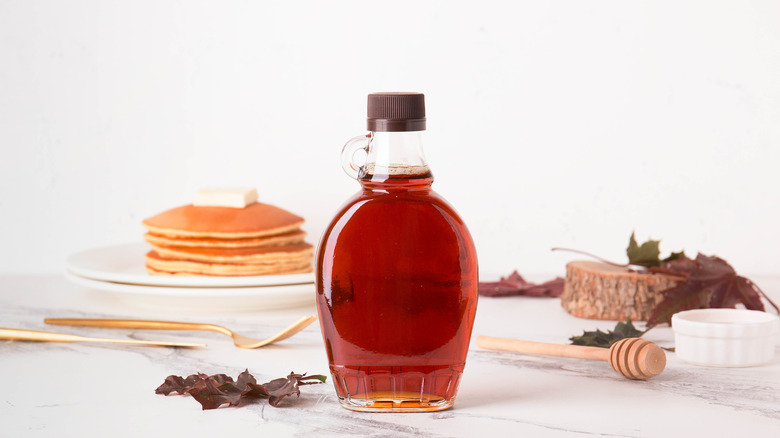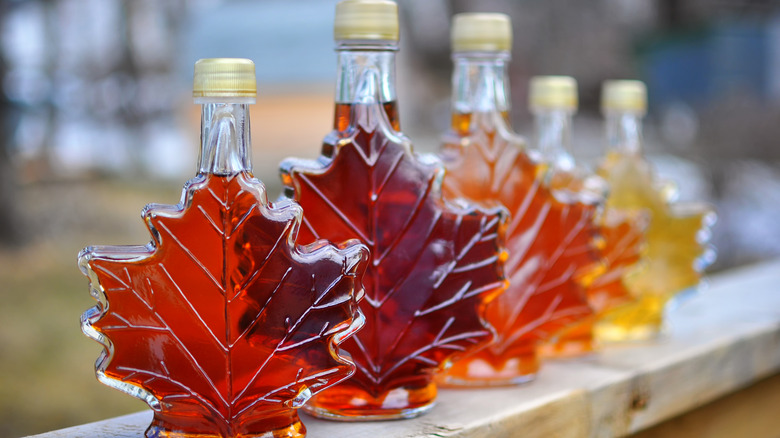We've Been Eating Pancakes And Syrup For Longer Than You May Have Thought
From piña colada sauce to creme brûlée, some creative toppings can transform simple pancakes into a breakfast feast. It's a great way to test your culinary skills if you're up to the challenge. But when all's said and done, nothing compares to the proper all-American breakfast that features a tall pancake tower with maple syrup dripping down the sides. It's delicious yet easy (and quick) to prepare, so you don't have to be a kitchen expert.
For many of us, this classic duo was a crucial part of our childhood, and it's still a breakfast treat that we love for comfort. But this tradition didn't start recently. Your parents (and possibly grandparents) may have enjoyed delicious syrup pancakes all their lives. It's been a household meal for hundreds of years, which is why we wanted to trace its origin. Let's explore how our ancestors discovered pancakes and maple syrup. We'll also examine the differences between real maple syrup and its lookalike: pancake syrup.
The first pancakes
Pancakes, or rather the precursor of this dish, have been a part of the human diet for tens of thousands of years. At the Shanidar Cave complex in Iraq, researchers uncovered remains of a flat dish that resembles the modern pancake. Ceren Kabukcu, the paper's lead author, shared with the Smithsonian Magazine that these 70,000-year-old leftovers appear to have been made from cooked seeds that were then crushed and flattened.
There are also several references to pancakes in ancient Roman and Greek literature. One of the oldest was written by Athenian poet Cratinus (500 BCE), where he speaks of a flat cake. Six hundred years later, Greek physician Galen wrote a book containing a recipe much like how one would make modern Canadian griddlecakes or Russian blinis. However, the word pancake hasn't been around for as long as the dish. The online Merriam-Webster dictionary traces the first time the word was used to the 14th century.
The evolution of pancakes through the years
Pancakes today differ significantly from what people ate in prehistoric times. The National Geographic explains that crude grinding tools from 30,000 years ago were used to process ferns, cattails, and other starchy plants into powder. According to researchers, the powders would then be mixed with water and baked on hot stones. The results were flat cakes likely harder than you'd typically prepare today.
From the writings of the Ancient Greeks and Romans, we start seeing references that more closely resemble modern pancakes. A classical Greek text by Galen titled, On the Properties of Foodstuffs shares directions for a simple pastry dish that you might find familiar. It reads, "The oil is placed in a frying pan that is put on a smokeless fire, and when it has become hot the wheaten flour, soaked in a large amount of water, is poured into it." As the flat sheet hardens, it's flipped over multiple times so that it's even all over, much like you would when preparing a pancake today.
Other ancient civilizations across the globe had variations of the flat cake made with locally available resources. For instance, during excavations at the Subeixi Cemeteries in the Northwestern region of China, researchers found millet pancakes dating back to 500 and 300 BCE. More recently, in the 18th century, Dutch migrants introduced pannekoek to America, which was made from buckwheat. Pancakes in this era were also called flapjacks, hoe cakes, or johnnycakes.
Pancakes from around the world
Across the world, different cultures have unique ways of preparing and enjoying pancakes. This savory dish is incorporated in feasts, religious rites, or may be the simple meal of the day. The classic American-style pancake is easy to make and requires only a few simple ingredients. They turn out to be soft, fluffy, and flat. But they're not as thin as French crêpes, which start with the same ingredients minus the baking powder.
Japanese fluffy pancakes are taller, silkier, and softer than the simple American type. When heated, the batter rises like soufflé because it contains baking powder and baking soda. Conversely, China's Scallion pancakes are thin and crispy. Nigerian pancakes may include additional ingredients like chopped onions and peppers, making them savory and slightly spicy. This is then paired with a hot beverage or various fillings to even out the flavor. In Uganda, there's a particular type of pancake called kabalagalas made from bananas and cassava flour. The batter is deep-fried until it's crispy brown on the outside but remains moist within.
Pancakes also hold a sacred place in some religions. For Christians in Western churches, Shrove Tuesday, which falls on the day before Ash Wednesday, is commemorated by feasting on pancakes. Jewish potato pancakes (Latkes) are also crucial to the Hannukah celebration.
Indigenous people discovered maple sugar
The history of maple syrup is just as fascinating as that of pancakes. Long before the pilgrims arrived, indigenous tribes had been harvesting and processing maple sugar from abundant maple trees. This ancient practice was a crucial part of their lifestyle that helped sustain the people of these communities. Maple extract had other uses besides sweetening food. Indigenous communities used it in curing meat and in traditional medicine mixtures. They would also dehydrate the maple sap to form sugar blocks that were traded.
Although there's no straightforward story of how Native American communities discovered maple sugar, many legends have been passed down for several generations. One Native American lore shared by the Chippewa and Ottawa tribes of Michigan explains the maple tree previously held pure syrup until the god, NenawBozhoo, cursed it. According to the story, this was to help people develop a deeper appreciation for nature and its gifts since they must work hard to get it. This curse transformed the once pure syrup within the trees into a watery sap that required several processing steps before use.
Native American tribes share this sweet treasure with settlers
When European settlers arrived, it didn't take them long to observe the way the Indigenous people harvested and processed maple syrup. In 1606, Marc Lescarbot wrote of how Micmac Indians of Eastern Canada distilled maple sap. Soon the newcomers had learned these techniques and were venturing into the forest where maple trees were abundant.
Early techniques employed by these settlers involved slashing the trees with an ax to let out the sap. But by 1790, they switched to using drills which helped preserve the trees after harvest. This technique involved boring a hole into the tree and inserting a spile through which the sap would run out. Next, the sap would be heated to concentrate the sugar into blocks.
Once again, maple sugar became a crucial part of the economy, as local families would sell their excess produce to purchase other essential products. Around 1818, maple sugar was more affordable and favored over cane sugar by shoppers. Eventually, cane sugar became the less expensive option, changing the trade dynamic. Since maple syrup had already grown in popularity, it maintained a stronghold in the market, while maple sugar became less popular.
How maple syrup is made
Making maple syrup begins with tapping fresh sap from mature trees (40 years and older) by boring holes into the trunk and letting the fluid run into containers. This event occurs during the sugaring season, which typically begins in February and lasts for six weeks on average.
The freshly tapped maple sap is usually clear and only a few steps away from the thick syrup that goes with pancakes. One of the ways indigenous communities produced maple syrup in the past involved freezing the sap overnight and then discarding the ice formed on top. This process is repeated several times until the residue thickens and turns brown. Another way Native tribes made maple syrup involves boiling down the sap to form a thick golden or amber syrup. They may also add heated rocks to the bowl of liquid to help raise the temperature quickly and cause water to evaporate.
With the advent of modern technology, making maple syrup has gotten more efficient. The harvested sap is first put in a reverse osmosis device to remove excess water. Next, it's transferred into a specialized evaporator that concentrates the mixture further. At the end of this process, 40 gallons of sap is transformed into 1 gallon of maple syrup.
Pancakes and maple syrup become a crucial part of the American diet
By the 18th century, pancakes had risen in popularity because they were affordable and relatively easy to prepare. One quote from the Country Housewife's Family Companion, written by William Ellis, appreciates how pancakes are such a great breakfast choice for farmers as it only requires ingredients they most likely had at home.
Maple syrup also has an interesting ride to fame as well. Although we can't point out the exact date maple syrup was first used as a topping for pancakes, there are some theories about how it began. Dave Smoke McCluskey, a Mohawk chef, spoke with the Martha Stewart website and shared that the Dutch Mohawk trade could have something to do with this. Dutch pancakes were traditionally enjoyed with apple syrup, so using maple syrup as an alternative wasn't far-fetched.
The Housekeeper's Assistant, published in 1845, is often regarded as the first book to mention pancakes and maple syrup as a food combination. From then on, pancakes and maple syrup became the powerful duo we love and enjoy.
Is maple syrup healthy?
Could something that tastes even sweeter than sugar really be healthy? You'd be surprised to learn that despite being so sweet, maple syrup is healthy because it doesn't affect your blood glucose levels the way table sugar does. According to Healthline, it has a low glycemic index of 54, which means it's less likely to cause a significant surge in blood sugar after consumption. Maple syrup provides essential nutrients like iron, zinc, manganese, calcium, magnesium, and vitamin B. It also has unique compounds, like quebecol, that may offer some health benefits.
However, there's one caveat to eating lots of maple syrup; it has so much sugar. One serving of maple syrup (83 grams) contains 50.2 grams of sugar. This is nearly twice what experts recommend daily. The American Heart Association strongly suggests that men shouldn't eat more than 36 grams of sugar daily, while the recommended threshold for women is 25 grams. Therefore, you don't want to go overboard even though you'd love to enjoy pancakes drenched in maple syrup. This is because consuming excessive sugar might predispose an individual to multiple health conditions, including cardiovascular disease, diabetes, kidney diseases, hypertension, and cognitive impairment.
Maple syrup vs. pancake syrup
Although maple and pancake syrups look alike and are typically drizzled over pancakes, their ingredients, taste, and price differ. Maple syrup usually costs more than pancake syrups, but this is because of its strenuous capital-intensive production process. Nevertheless, it's well worth the investment as it has a rich, slightly toasted flavor that most alternative syrup brands can't provide.
Maple syrup is obtained from pure maple sap that's been boiled to remove water. The resulting thick syrup has no coloring, flavors, or sweeteners added. On the other hand, most pancake syrup brands, such as Pearl Milling Company (Aunt Jemima), Mrs. Butterworth's, and Log Cabin, don't even have a drop of maple syrup. Instead, they contain a mixture of corn syrup, flavor, color, and preservatives.
Some consumers prefer pure maple syrup because even though it generally has more sugar than pancake syrups, it's completely natural, with no additives. Pancake syrups also lack essential compounds, such as quebecol, that enhance maple syrup's nutritional value. It's clear that both products have their pros and cons, so the final decision of which one you should drizzle on your breakfast depends on your tastes and diet.
